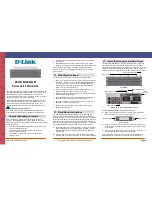
SIEMENS ADSL E-110_E-110-I user manual
•
PVC (Permanent Virtual Circuit)
A PVC is a logical point-to-point circuit between customer sites. PVCs are low-delay circuits because
routing decisions do not need to be made along the way. Permanent means that the circuit is
preprogrammed by the carrier as a path through the network. It does not need to be set up or torn
down for each session.
•
RIP (Routing Information Protocol)
RIP is a routing protocol that uses the distance-vector routing algorithms to calculate least-hops
routes to a destination. It is used on the Internet and is common in the NetWare environment. It
exchanges routing information with other routers. It includes V1, V2 and V1&V2, which controls the
sending and receiving of RIP packets over Ethernet.
•
UDP (User Datagram Protocol)
UDP is a connectionless transport service that dispenses with the reliability services provided by TCP.
UDP gives applications a direct interface with IP and the ability to address a particular application
process running on a host via a port number without setting up a connection session.
•
Virtual Server
You can designate virtual servers, e.g., a FTP, Web, telnet or mail server, on your local network and
make them accessible to the outside world. A virtual server means that it is not a dedicated server --
that is, the entire computer is not dedicated to running on the public network but in the private
network.
•
VPI (Virtual Path Identifier) & VCI (Virtual Channel Identifier)
A VPI is a 8-bit field while VCI is a 16-bit field in the ATM cell header. A VPI identifies a link formed by
a virtual path and a VCI identifies a channel within a virtual path. In this way, the cells belonging to
the same connection can be distinguished. A unique and separate VPI/VCI identifier is assigned in
advance to indicate which type of cell is following, unassigned cells, physical layer OAM cells,
metasignalling channel or a generic broadcast signaling channel. Your ISP should supply you with the
values.
82
Rev:01_040220



































